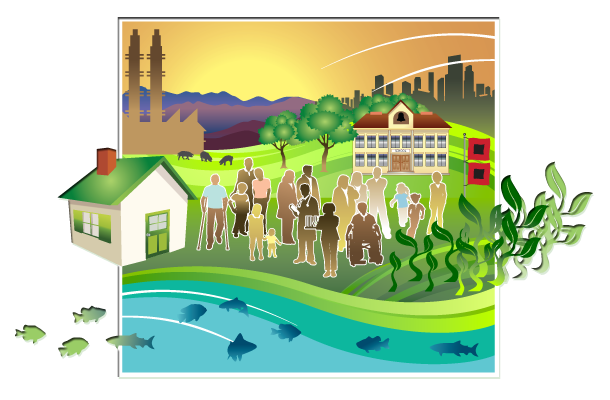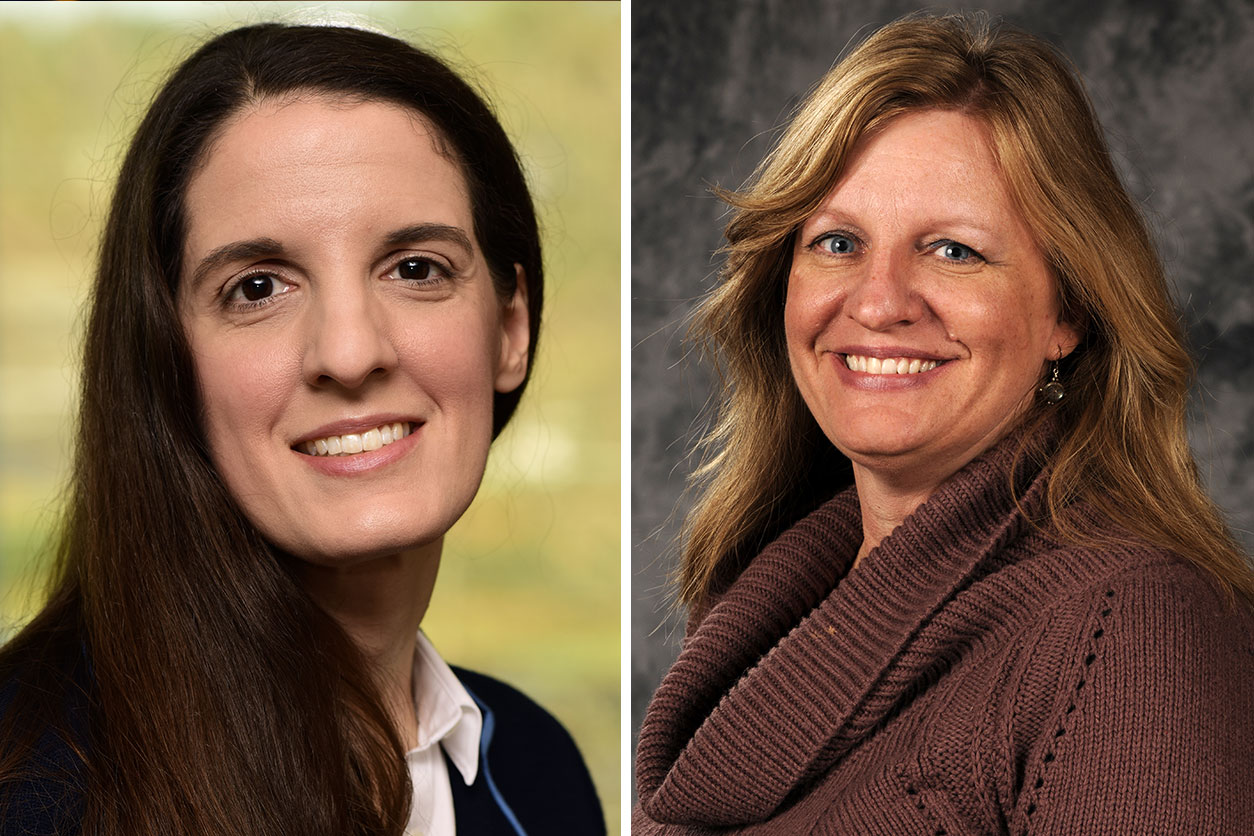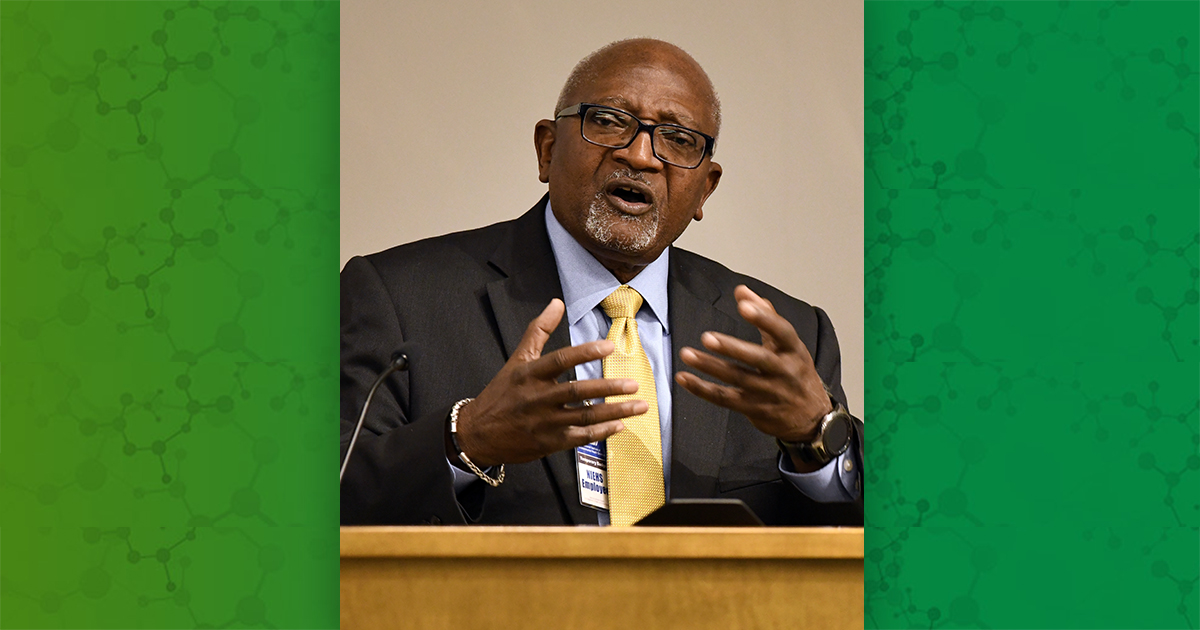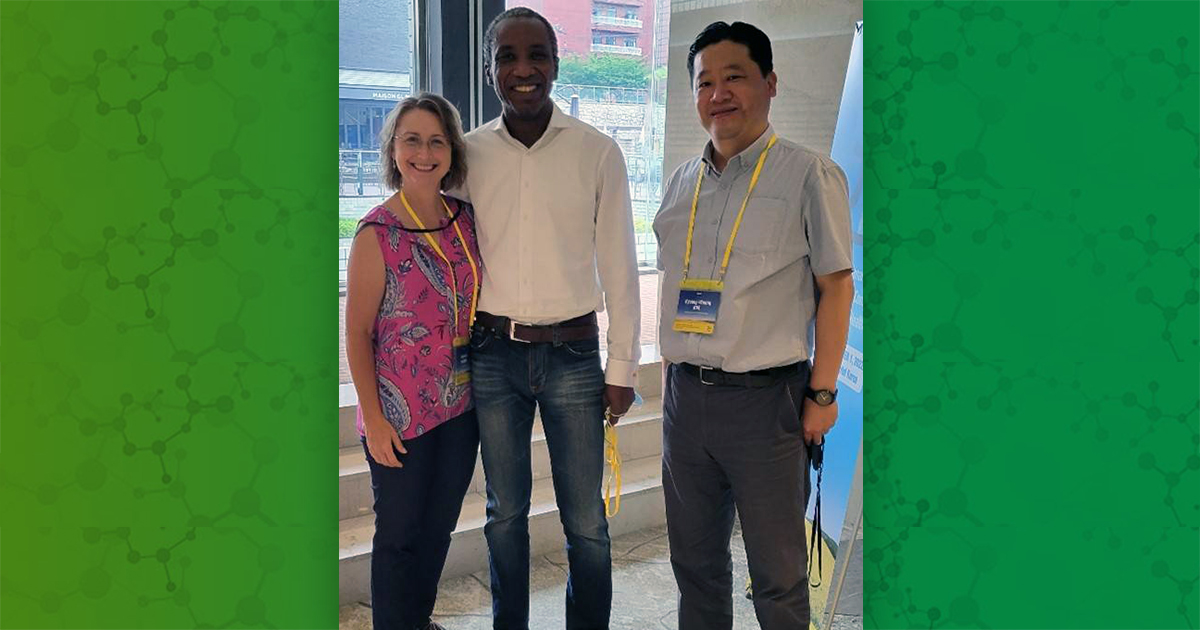Community Stories Help Researchers Map the Spread of Air Pollutants
Community stories about pollution were found to overlap the locations of a burn facility’s smoke plume, helping scientists improve their exposure assessment technique. Researchers at Louisiana State University, North Carolina State University, and Tulane University engaged with residents in Colfax, Louisiana, and local community partners to characterize the community’s concerns about exposure to environmental pollutants from a nearby commercial open burn/open detonation thermal hazardous waste treatment facility. The facility processes military ordnances, fireworks, propellants, and waste from Superfund sites.
A June 2022 paper describes how the researchers recorded oral histories with community members and mapped their locations. They then compared residents’ complaints to toxicological data showing a more complete picture of how contaminants spread geographically from the burn facility.
“In The Rock, a low-income enclave just south of the facility, we were able to visualize hot spots for symptoms related to health impacts to the thyroid, respiratory system, and skin, among other endpoints, as well as property damage,” stated Jennifer Richmond-Bryant, Ph.D., director of this Louisiana State University Superfund Research Program project and an associate professor at North Carolina State University. “Our results helped us to develop a proposal to the community for the locations for placing our environmental samplers as well as documenting the community members’ experiences.”
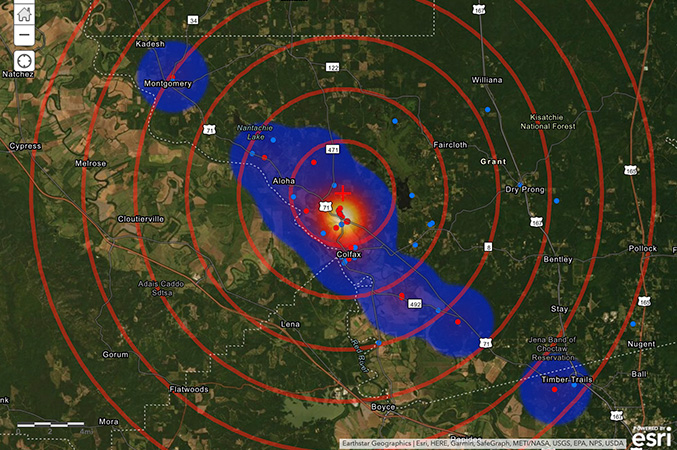
The red plus sign indicates the location of the burn facility, and red circles indicate 5-kilometer intervals. All dots indicate community members’ locations, while red dots indicate locations where respiratory disease was reported. The heat map of blue to yellow colors indicates concentration of respiratory disease cases, with yellow as the highest. (Image courtesy of Jennifer Richmond-Bryant)
Hearing from the Community
Colfax is a rural community in which a majority of residents are Black. The community experiences numerous disadvantages, including high unemployment, a large percentage of residents with less than a high school education, and a high percentage living below twice the poverty level. The burn facility sits approximately 5 miles north of the center of Colfax and a mile from The Rock enclave. Hazardous environmental exposures from this facility are an added burden, creating an environmental justice issue.
In 2018, the Louisiana Department of Environmental Quality (LDEQ) held a public hearing on the possible expansion of the burn facility, and 53 residents provided comments. To get more data, two community organizations reached out to the research team to measure pollution levels. The organizations were the Louisiana Environmental Action Network, a community-based not-for-profit organization that addresses environmental struggles in the state, and Central Louisiana Coalition for a Clean and Healthy Environment, a community organization started in 2016 to oppose the burning of hazardous waste at the facility. The research team then developed a sampling strategy and interviewed residents about their experiences.
The research team recruited interviewees through community partners and church pastors, and by choosing phone numbers at random from a phone book. University oral historian colleagues worked with the researchers to develop community-appropriate, open-ended interview questions.
Researchers conducted both in-person and phone interviews between January 2020 and January 2021. Residents shared details of the toll of living near the burn facility. Their comments were categorized according to the health, pollution, or property concern mentioned in the conversation.
In the article, one community member described the impact of the facility on her children: “The children can’t go out and play like they used to. They complain about scratching and itching and stuff like that, and stuff falling from the sky. You know it’s just big headaches, so [they] stay inside now.”
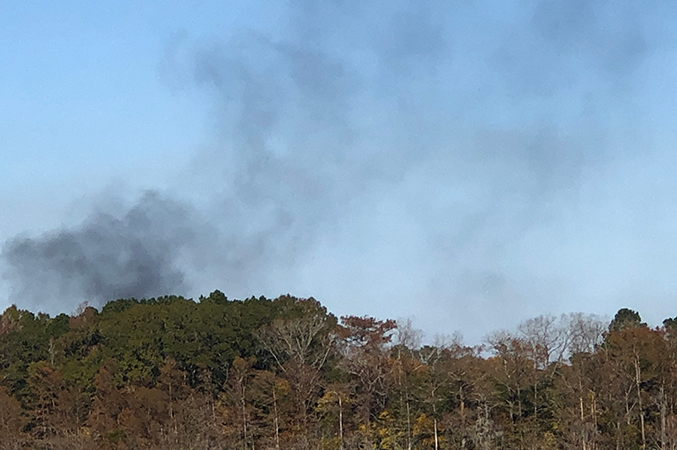
Smoke from the burn facility seen in the Colfax community. (Photo courtesy of Jennifer Richmond-Bryant)
Mapping Comments and Environmental Hazards Using Geographic Information Systems
Using geographic information software, researchers visualized the concentration of reported concerns by topic, such as respiratory problems, skin problems, home damage, or seeing smoke. Of the 65 community members who provided comments, with some participating in both the LDEQ meeting and the interviews, more than half described health problems, such as respiratory, skin, and thyroid issues. About half of the people noted hearing explosions or stated they had damage to their homes.
To determine whether the environmental hazards from the facility could reach the Colfax community, researchers used National Oceanographic and Atmospheric Administration software that accounts for weather and atmospheric conditions. The software allows researchers to model how contaminants would have spread through the air on the days for which LDEQ obtained burn data. The models indicated that contaminants from the burn facility likely reached the local Colfax community. Importantly, maps of residents’ health concerns overlapped with the exposure models. Furthermore, researchers used the PubChem database to determine that the materials burned at the facility are associated with many of the health concerns residents reported.
“Our modeling efforts validate residents’ narratives about the facility’s impact,” stated Richmond-Bryant. “Not surprisingly, hot spots from residents’ testimony about health effects line up with our plume models and with the known health effects of the compounds being burned at the facility. The residents’ oral histories are a critical foundational step for the work to make sure that we are locating our samplers and analyzing for compounds that will have the greatest impact on the community.”
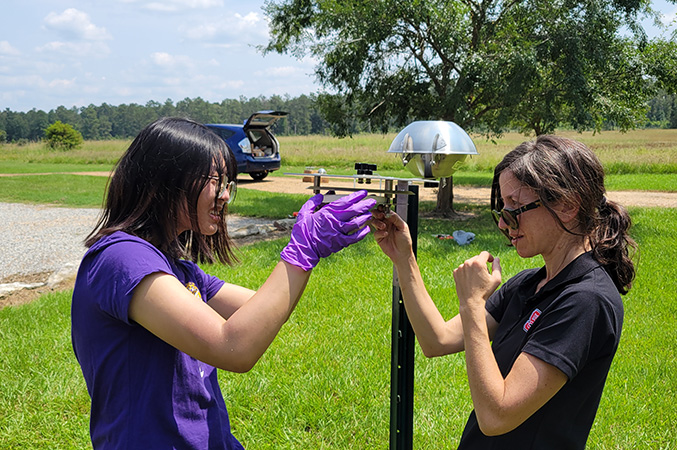
Members of the research team set up an air quality monitoring device outside a Colfax resident’s home. (Photo courtesy of Jennifer Richmond-Bryant)
The research team hopes to gather additional evidence of the extent of hazardous exposures in the community, and in March 2022, they began to monitor the air quality outside several residents’ homes.
Brenda Vallee, lifelong Colfax resident and head of the Central Louisiana Coalition for a Clean and Healthy Environment, reflected on the impact of the exposure assessment so far: “Outside agencies have looked at the research and have asked questions. The research group responded and provided data.”
Applications Open for Urban Heat Island Mapping Campaign
The National Oceanic and Atmospheric Administration is hosting the seventh Urban Heat Island mapping campaign. Organizations, such as local universities, nonprofits, or city health departments, that want to better understand extreme heat can apply to partake in these summer campaigns, during which citizen scientist volunteers will travel around their cities to collect data on temperature, humidity, time, and location. The data are then used to produce a detailed analysis of heat in the mornings, afternoons, and evenings, and are intended to allow communities to take action to lessen the health burdens of extreme heat. The 2023 program is part of the Justice40 Initiative. Applicants will need to describe how their work will support environmental justice in their communities, and participants will need to track and report on the allocation of benefits to disadvantaged communities. Applications are due December 16.
Federal Initiative Aims to Train Future Public Health Professionals
AmeriCorps and the U.S. Centers for Disease Control and Prevention launched an initiative, Public Health AmeriCorps, to address the nation’s public health needs resulting from the COVID-19 pandemic. The program supports the recruitment and training of the next generation of public health professionals through funding from the American Rescue Plan and focuses on rebuilding and improving strained public health systems. The Corps’ first director, A.J. Pearlman, J.D., hopes the program will address the public health needs of local communities while also creating pathways to quality careers in public health. AmeriCorps, the U.S. federal agency for national service and volunteerism, enables Americans to serve their country by addressing the nation’s most pressing challenges and improving communities.
The 2023 grant program prioritizes applicants, including nonprofit and community-based organizations and local public health departments, that are addressing community public health needs, such as health inequities worsened by the pandemic. The grants provide funding to awardees to recruit Public Health AmeriCorps members to serve locally. The next application deadline is January 4, 2023, and any organizations with innovative solutions that address COVID-19-related public health concerns are encouraged to apply, even if they have not previously received AmeriCorps funding. More information about the grant criteria is available.
U.S. Environmental Protection Agency Finalizes Environmental Justice Action Plan
The U.S. Environmental Protection Agency (EPA) finalized its environmental justice action plan in September. The plan, Building Up Environmental Justice in EPA’s Land Protection and Cleanup Programs, highlights resources and practices that will be applied to several EPA efforts, such as its Superfund, Brownfields, and Emergency Response programs. EPA incorporated feedback from stakeholders, including Tribal partners, when finalizing the plan, which includes four main goals:
EPA also announced in September that it had created a new Office of Environmental Justice and External Civil Rights to support the actions outlined in the plan. The new office provides leadership and coordinates efforts across the agency relevant to civil rights and environmental justice, engages with communities with environmental justice concerns, and enforces federal civil rights laws that prohibit discrimination by applicants for and recipients of EPA financial assistance. It will also oversee the delivery of funds in the climate and environmental justice block grant program that was created by the Inflation Reduction Act.
For more information, read the press releases on the finalization of the action plan and the launch of the new office.
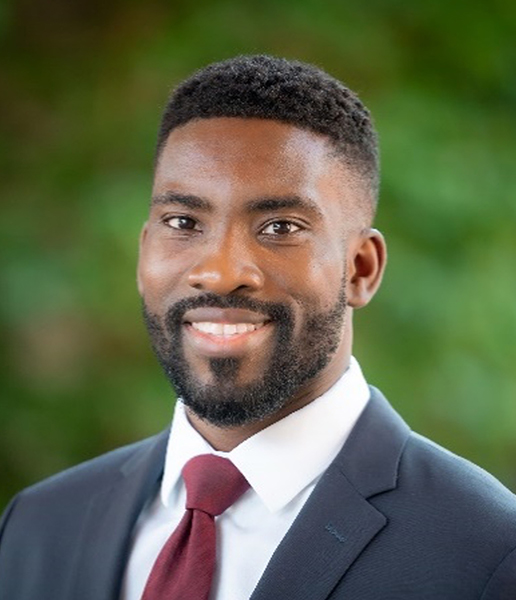
PEPH Grantee Highlight
Jamaji Nwanaji-Enwerem, M.D., Ph.D., M.P.P.
Jamaji Nwanaji-Enwerem, M.D., Ph.D., M.P.P., splits his time between treating patients as an emergency medicine resident doctor, teaching as an adjunct professor, and advocating for environmental health issues to address health disparities. As a former NIEHS-funded postdoctoral fellow, Nwanaji-Enwerem researched how environmental exposures change the rate of biological aging, which can be a biomarker for predicting disease outcomes. He is currently an emergency medicine resident doctor at Emory University’s School of Medicine and an adjunct assistant professor at the School of Public Health. Nwanaji-Enwerem is passionate about using his expertise to support community efforts to address health disparities. He launched and is the Executive Director of ELND, an initiative that promotes community-level projects in Africa. The initiative sponsored a photo contest that raised awareness of residents’ efforts to address environmental issues in their communities, leading to funding that continues to support that work.
Funding Opportunities
Mechanism for Time-Sensitive Research Opportunities in Environmental Health Sciences (R21 Clinical Trial Not Allowed)
This funding opportunity announcement (FOA) has been extended (NOT-ES-22-013). This FOA is intended to support novel environmental health research in which an unpredictable event or policy change provides a limited window of opportunity to collect human biological samples or environmental exposure data. The primary motivation of the FOA is to understand the consequences of natural and human-made disasters, emerging environmental public health threats, and policy changes in the U.S. and abroad. The distinguishing features of an appropriate study are 1) the unforeseen nature of the event, 2) the clear scientific value and feasibility of the study and 3) the need for rapid review and funding, substantially shorter than the typical NIH grant review/award cycle, for the scientific question to be approached and for the research design to be implemented. It should be clear that the event offers a limited opportunity to address unique and important research questions that could only be answered if the project is initiated with minimum delay. Investigators should describe their capacity to begin the project upon award.
Deadlines: November 10, 2022; December 1, 2022; January 3, 2023; February 1, 2023
Maternal Health Research Centers of Excellence (U54 Clinical Trial Optional)
Invites applications to participate as a Research Center as part of the Maternal Health Research Centers of Excellence initiative. The purpose of this initiative is to generate innovative approaches to address preventable maternal mortality, decrease severe maternal morbidity, and promote maternal health equity in partnership with communities that are most affected (i.e., Blacks/African Americans, American Indians/Alaska Natives, Hispanics/Latinos, Asian Americans, Native Hawaiians and other Pacific Islanders, sexual and gender minorities, socioeconomically disadvantaged populations, and underserved rural populations). Persons with disabilities are also a priority population. This initiative will use an integrated multi-level approach encompassing structural, social, and biobehavioral research strategies to address the multiple contributing factors that lead to adverse maternal health outcomes and health disparities. Proposed research can address maternal health in the pre-pregnancy, pregnancy, or postpartum period, provided that the research outcomes directly address severe maternal morbidity and/or maternal mortality and equitable health care. This funding opportunity announcement (FOA) runs in parallel with companion FOAs that seek applications for an Implementation Science Hub/Resource Center (RFA-HD-23-037) and a Data Innovation and Coordinating Hub/Resource Center (RFA-HD-23-036). It is expected that all components of the Centers of Excellence, Research Centers, and Hubs, work collaboratively to design and implement research projects, including data collection and data sharing.
Letter of Intent Due Date: November 2, 2022
Deadline: December 5, 2022
PHS 2022-2 Omnibus Solicitation of the NIH, CDC, and FDA for Small Business Innovation Research Grant Applications (Parent SBIR [R43/R44] Clinical Trial Not Allowed)
Enables U.S. owned-and-operated small businesses to conduct research and development that has a strong potential for commercialization. This award and the associated PHS 2022-2 Omnibus Solicitation of the NIH and CDC for Small Business Innovation Research Grant Applications (Parent SBIR [R43/R44] Clinical Trial Required) provide funds for small businesses to stimulate technological innovation in the private sector and strengthen the role of small business in meeting federal research and development needs. The related Small Business Technology Transfer announcements [PHS 2022-2 Omnibus Solicitation of the NIH for Small Business Technology Transfer Grant Applications (Parent STTR [R41/R42] Clinical Trial Not Allowed) and PHS 2022-2 Omnibus Solicitation of the NIH for Small Business Technology Transfer Grant Applications (Parent STTR [R41/R42] Clinical Trial Required)] aim to foster technology transfer through cooperative research and development between small businesses and research institutions.
Deadlines: January 5, 2023; April 5, 2023
Notice of Special Interest (NOSI): Administrative Supplements for Research on Sex And/Or Gender Influences (Admin Supp Clinical Trial Optional)
Supports research highlighting the impact of sex and/or gender influences in human health and illness. The proposed research must address at least one objective from the five strategic goals of the 2019-2023 Trans-NIH Strategic Plan for Women's Health Research. A broad range of research topics studied at the basic, pre-clinical, translational, and clinical levels that address the role of sex and/or gender in health and disease are encouraged. Studies that explore sex or gender influences or the intersection of sex and gender are also encouraged.
Deadlines: January 26, 2022; January 26, 2023
Notice of Special Interest (NOSI): Research on the Health of Women of Understudied, Underrepresented and Underreported (U3) Populations (Admin Supp Clinical Trial Optional)
Supports projects highlighting common sources of disparities in women and girls’ health with a specific emphasis on those that integrate measures beyond the individual level and consider perspectives from multiple disciplines. A broad range of research topics studied at the preclinical, clinical, behavioral, and translational levels are encouraged. Proposals incorporating multilevel interventions, using community-engaged approaches, and focusing on one or more NIH-designated health disparities populations are also desired.
Deadline: January 31, 2022
Accelerating the Pace of Child Health Research Using Existing Data From the Adolescent Brain Cognitive Development (ABCD) Study (R01-clinical Trial Not Allowed)
Supports activities proposing to conduct analyses of existing ABCD Study data to accelerate the pace of research on child health and development, including: cross-sectional and/or longitudinal analyses; development of new or advanced statistical methods; and/or integration of ABCD data with other existing datasets that share common data elements. NIEHS is interested in applications that will use ABCD data resources to examine the contribution of environmental exposures on brain and development and to identify sensitive time windows of development that may confer individual susceptibility and also to identify protective factors that may mitigate environmental-induced changes. An R21 funding opportunity is also open.
Deadlines: June 5, 2022; October 5, 2022; February 5, 2023
Research to Action: Assessing and Addressing Community Exposures to Environmental Contaminants (R01 Clinical Trial Optional)
Encourages multidisciplinary projects to investigate the potential health risks of environmental exposures of concern to a community and to implement an environmental public health action plan based on research findings. Projects supported under this program are expected to employ community-engaged research methods to not only conduct research but also to seamlessly translate research findings into public health action. Check out the Research to Action Currently Funded Grantees webpage for a sense of the types of projects supported through this FOA.
Deadline: January 21, 2020




